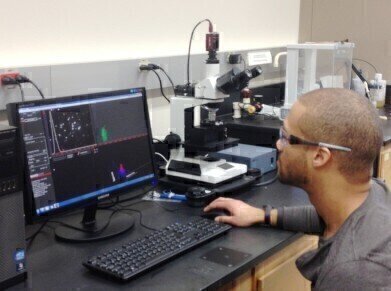Microscopy & Microtechniques
Illinois State University use NTA in their development of Novel Bioanalytical Assays
May 24 2013
NanoSight reports on how Nanoparticle Tracking Analysis, NTA, is being used in the development of novel bioanalytical assays at Illinois State University.
Speeding up the detection and identification of viruses is one of the areas of new research of Illinois State University Assistant Professor of Chemistry Jeremy Driskell. This has been recognised by the US Department of Defense in their recent award of a major grant. Reliable and accurate nanoparticle composition is important in such work.
Here, Dr Driskell describes how he has used various techniques.
Talking about his current work, Dr Driskell says "Our research group is focused on the development of novel bioanalytical assays which includes detection of nucleic acids, proteins, and whole viruses. While other groups aim to improve assay sensitivity or detection limits, our central focus is on reducing assay speed and complexity. We are currently using gold nanoparticles and gold filters to develop assays utilising surface-enhanced Raman spectroscopy for detection. In the process of characterising the gold nanoparticles and monitoring the modification steps required for the SERS assays, we found that particle sizing techniques such as Dynamic Light Scattering (DLS) and Nanoparticle Tracking Analysis (NTA) could also be used for assay readout. This finding and application is detailed in our recent publication in the Analyst."
Dr Driskell continued: "We began by using DLS to characterise gold nanoparticles that we modify with Raman reporter molecules and antibodies. This was a simple means of detecting particle aggregation as a result of surface modification and is more sensitive than colorimetric detection, which we found was not useful for conditions that invoked slight aggregation. When we learned of NanoSight and NTA, we compared the data to DLS. For our purposes, NTA gave a much more accurate representation of the actual particle sizes in our solutions. DLS would frequently indicate aggregation of a nanoparticle population while NTA revealed few large aggregates while the majority of the particles remained monodisperse. Ultimately we concluded it was a better technique to give us a better understanding of nanoparticle composition (aggregates compared with individual particles) in terms of absolute numbers."
Digital Edition
International Labmate Buyers' Guide 2024/25
June 2024
Buyers' Guide featuring: Product Listings & Manufacturers Directory Chromatography Articles - Enhancing HPLC Field Service with fast-response, non-invasive flowmeters - Digital transformatio...
View all digital editions
Events
Jul 03 2024 Gandhinagar, India
Jul 07 2024 Dublin, Ireland
Jul 20 2024 Denver, CO, USA
Jul 21 2024 Cape Town, South Africa
Jul 28 2024 San Diego, CA USA


















